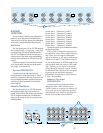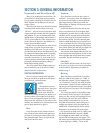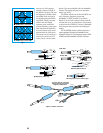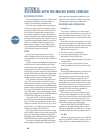
21
HI MID Variable 1: Boost/Cut
HI MID Variable 2: Bandwidth
HI MID Variable 3: Band Center
3 HI MID VARIABLES
many recorders, and no amplifiers, that can tol-
erate such high signal levels. Therefore, it’s best
that the red LEDs never light up.
But, if your music is sounding good, don’t
worry if you’re in the yellow a lot or if some parts
of the track hardly read at all. You’ll quickly get a
feel for what works for you, when you can get
away with really smacking the tape or the elec-
tronics too much.
BUSES
More often than not, the goal in a mixing con-
sole is to mix two or more inputs into one
output. Like a coach who has two or more play-
ers to get to the same ballgame, console
designers use a bus. Even Webster’s Unabridged
Dictionary agrees, defining the word bus in elec-
tronics as “a conductor serving as a common
connector for three or more circuits.”
The Mackie 8•Bus Series has, in fact, many
more than eight buses. The eight memorialized
in the name are important, but there are also six
AUXiliary buses, a pair of L/R Mix buses, the al-
ternate pair of MIX-B buses, and a pair of Solo
buses. We will try to be clear just what bus we
are talking about when we do talk about buses.
SENDS AND RETURNS
Sends are outputs, and returns are inputs. So
why don’t we call them outputs and inputs?
Well, actually, the terms send and return can
mean many things, but the way they are gener-
ally used in mixing console parlance is to refer to
sends, which tap off a little of a signal to send to
some effects device (like a reverberation unit),
and returns, which function to return that reverb
back into the mix.
Sends are also used to tap some mix of signal
from a collection of channels for a headphone
cue mix. For that matter, sends can be used as
additional mix buses, if needed.
In the same way, if you don’t need them for
reverb or effects, returns can be used as addi-
tional inputs to your mix.
SOLO
Solo is a standard console function that al-
lows you to listen to one or more sources all by
themselves (soloed).
You can check EQ, possible distortion or buzz,
or just listen to see if a particular mic is open or
not. This function can also be handled by each
channel’s -20/OL LEDs. See Section 2 “–20 and
OL LEDs” for more details. When soloing more
than one source, you can listen to the blend of
just part of your mix: only the sopranos, for ex-
ample, or just the tom mics on the drums.
The solo circuits are designed not to inter-
rupt the recording process. The solo bus signal
is sent directly to the control-room monitors
without affecting any of the inputs, outputs or
recording buses.
When you are mixing or monitoring with re-
verb, remember to not only solo the channel
you’d like to hear, but also the AUX Return carry-
ing your reverb. Otherwise, you will hear the
channel soloed dry, without its echo.
EQ
Everybody knows what EQ is, but just in case
you’d like a refresher, we’ll put in a few para-
graphs here.
Equalization (EQ) refers to purposely chang-
ing the frequency response of a circuit,
sometimes to correct for previous unequal re-
sponse (hence the term, equalization), and more
often to add or subtract level at certain frequen-
cies for a pleasing effect.
Bass and treble controls on your stereo are
EQ; so are the devices called parametrics and
graphics and notch filters.
A lot of how we refer to equalization has to do
with what a graph of the frequency response
would look like. A flat response (no EQ) is a
straight line; a peak looks like a hill, a dip is a
valley, a notch is a really skinny valley, and a
shelf looks like a plateau (or a
shelf). The slope is the grade
of the hill on the graph. For in-
stance, if you lived in Texas,
you would set y’all’s EQs flat.
Graphic equalizers have
enough frequency slider con-
trols to form a graph of the EQ
right on the front panel. Para-
metric EQs let you vary several
EQ parameters at once. A fil-
ter is simply a form of
equalizer that allows certain
frequencies through unmo-
lested and either reduces
other frequencies or elimi-
nates them entirely.
The equalizer on the 8•Bus
Series combines several differ-
ent types of EQ into five
different sections.
The HI MID EQ section is a
fully parametric equalizer.
This means all the significant
parameters can be varied, as
you can see in Figure 1. The
Fig.1
GENERAL
INFO


















